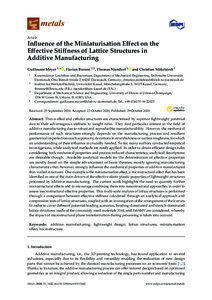| dc.date.accessioned | 2023-08-10T09:43:34Z | |
| dc.date.available | 2023-08-10T09:43:34Z | |
| dc.date.issued | 2020-10-29 | |
| dc.identifier | doi:10.17170/kobra-202308108597 | |
| dc.identifier.uri | http://hdl.handle.net/123456789/14980 | |
| dc.language.iso | eng | |
| dc.rights | Namensnennung 4.0 International | * |
| dc.rights.uri | http://creativecommons.org/licenses/by/4.0/ | * |
| dc.subject | additive manufacturing | eng |
| dc.subject | lightweight design | eng |
| dc.subject | lattice structures | eng |
| dc.subject | miniaturisation effect | eng |
| dc.subject | microstructure | eng |
| dc.subject.ddc | 600 | |
| dc.title | Influence of the Miniaturisation Effect on the Effective Stiffness of Lattice Structures in Additive Manufacturing | eng |
| dc.type | Aufsatz | |
| dcterms.abstract | Thin-walled and cellular structures are characterised by superior lightweight potential due to their advantageous stiffness to weight ratio. They find particular interest in the field of additive manufacturing due to robust and reproducible manufacturability. However, the mechanical performance of such structures strongly depends on the manufacturing process and resultant geometrical imperfections such as porosity, deviations in strut thickness or surface roughness, for which an understanding of their influence is crucially needed. So far, many authors conducted empirical investigations, while analytical methods are rarely applied. In order to obtain efficient design rules considering both mechanical properties and process induced characteristics, analytical descriptions are desirable though. Available analytical models for the determination of effective properties are mostly based on the simple advancement of beam theories, mostly ignoring manufacturing characteristics that, however, strongly influence the mechanical properties of additive manufactured thin-walled structures. One example is the miniaturisation effect, a microstructural effect that has been identified as one of the main drivers of the effective elasto-plastic properties of lightweight structures processed by additive manufacturing. The current work highlights the need to quantify further microstructural effects and to encourage combining them into mesostructural approaches in order to assess macrostructural effective properties. This multi-scale analysis of lattice structures is performed through a comparison between effective stiffness calculated through an analytical approach and compression tests of lattice structures, coupled with an investigation of the arrangement of their struts. In order to cover different potential loading scenarios, bending-dominated and stretch-dominated lattice structures made of the commonly used materials 316L and Ti6Al4V are considered, whereby the impact of microstructural phase transformation during processing is taken into account. | eng |
| dcterms.accessRights | open access | |
| dcterms.creator | Meyer, Guillaume | |
| dcterms.creator | Brenne, Florian | |
| dcterms.creator | Niendorf, Thomas | |
| dcterms.creator | Mittelstedt, Christian | |
| dcterms.extent | 18 Seiten | |
| dc.relation.doi | doi:10.3390/met10111442 | |
| dc.subject.swd | Rapid Prototyping <Fertigung> | ger |
| dc.subject.swd | Leichtbau | ger |
| dc.subject.swd | Mikrostruktur | ger |
| dc.subject.swd | Miniaturisierung | ger |
| dc.type.version | publishedVersion | |
| dcterms.source.identifier | eissn:2075-4701 | |
| dcterms.source.issue | Issue 11 | |
| dcterms.source.journal | Metals | eng |
| dcterms.source.volume | Volume 10 | |
| kup.iskup | false | |
| dcterms.source.articlenumber | 1442 | |


